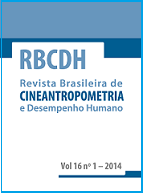Discriminant analysis of pubertal maturation in young males based on anthropometric characteristics
DOI:
https://doi.org/10.1590/1980-0037.2014v16n1p96Abstract
The relationship between anthropometric variables and maturation stages is important for a more detailed monitoring of pubertal development and may provide a suitable tool for clinical diagnosis. The aim of this study was to analyze the predictive contribution of anthropometric variables to pubertal maturation using multivariate discri-minant analysis. A total of 190 boys aged 8 to 18 years, from public and private schools in Natal, Brazil, participated in the study. Thirty-two anthropometric variables were measured and pubertal maturation was evaluated objectively by observing pubic hair development. Measures of central tendency and dispersion, inferential analysis of variance, and multi-variate discriminant analysis were used for statistical analysis. Pubertal advancement was accompanied by significant changes in anthropometric variables (p<0.05). Discriminant analysis identified eight variables with a high predictive capacity of pubertal maturation: age, sitting height, biacromial breadth, acromiale-radiale, trochanterion-tibiale laterale and tibiale laterale bone lengths, and abdominal and forearm girths. The anthropometric variables showed a high correlation with the classification of pubertal maturation, dem-onstrating a high predictive level among them. These findings indicate the possibility of developing a predictive equation for pubertal stages.



